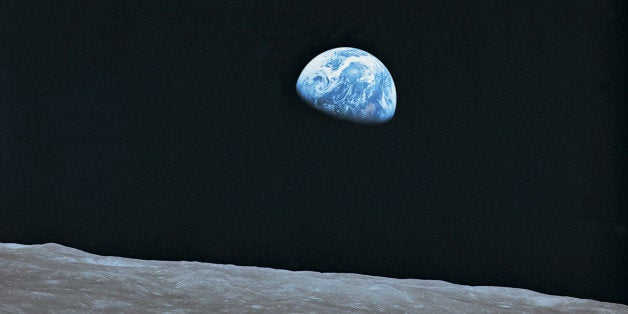
Five teams competing for the $30-million Google Lunar XPRIZE have just been awarded a combined $5.25 million for meeting significant milestones in developing a robot that can safely land on the surface of the Moon, travel 500 meters over the lunar surface, and send "Mooncasts" back to Earth. A tiny startup from India with no experience in robotics or space flight, Team Indus, just won $1 million of this prize. It stood head-to-head with companies that had been funded by billionaires, had received the assistance of NASA, and had the support of leading universities.
The good news is that governments no longer have a monopoly on space exploration. In two or three decades we will have entrepreneurs taking us on private spaceflights to the Moon. That is what has become possible.
What has changed since the days of the Apollo moon landings is that the cost of building technologies has dropped exponentially. What cost billions of dollars then costs millions now, and sometimes even less. Our smartphones have computers that are more powerful than the Cray supercomputers of yesteryear, which had strict export controls and cost tens of millions of dollars. We carry in our pockets high-definition cameras that are more powerful than those on NASA spacecraft. The cameras in the Mars Curiosity rover, for example, have a resolution of 2 megapixels with 8 gigabytes of flash memory, the same as our clunky first-generation iPhones. The Apollo Guidance Computer, which took humans to the Moon in 1966, had a 2.048-megahertz processor -- slower than those you find in calculators and musical greeting cards.
The same technologies that are available in the United States and Europe are available worldwide. Innovation has globalized.
I met Team Indus while I was in Mumbai to speak at INK last November. When they told me they were competing for the Google Lunar XPRIZE, I didn't take them seriously, because I had seen their counterpart in Silicon Valley, Moon Express, which has the support of tech moguls such as Naveen Jain. How could a scrawny little startup in Bangalore take on Naveen Jain, former NASA engineer Bob Richards, and NASA itself? I thought. The Moon Express team is a force of nature, has the advantage of being on the NASA Ames Research campus, and has been given billions of dollars in research and development by NASA.
Team Indus was also up against Astrobotic, which is a spinoff from the Carnegie Mellon University Robotics Institute, and Israel-based SpaceIL, which has the backing of the country's top research institutes.
The company's win blew my mind. Even though the subject of my INK talk was how Indian entrepreneurs could help change the world, I didn't think it was already happening.
(Watch this talk to learn more: "Why India Shouldn't Be Succeeding but Is.")
The Bangalore-based startup was founded by former IT executive Rahul Narayan and four of his friends: an Air Force pilot, a marketing executive, an investment banker, and an aerospace engineer. None of the team had experience in building spacecraft or robots, yet they were able to build technology that could navigate to the Moon.
Narayan says he expects completion of his space mission to cost around $30 million. Moon Express Chief Executive Bob Richards estimates $50 million. These numbers are higher than the $20-million prize that they hope to win. But both see far greater opportunities: They hope to be pioneers in what could be a trillion-dollar industry. Richards is looking to mine the Moon for minerals and bring them back to Earth. Each payload could be worth billions.
The Google Lunar XPRIZE has 26 teams competing from around the world. Collectively, they will spend in the hundreds of millions of dollars on their efforts. For them, it is not all about winning the contest; many of the losers will still commercialize their space technologies or put their knowledge to use in other fields. This is the power of such competitions. They lead entrants to spend multiples of the offered purse on innovative solutions. And they motivate people outside the industry, such as Narayan, to enter it with out-of-the-box thinking.
Innovation prizes are not new. In fact, a number of celebrated historical feats were made possible, in part, by the desire to win these prizes. In the 1920s New York hotel owner Raymond Orteig offered a $25,000 prize to the first person to fly non-stop between New York and Paris. Several unsuccessful attempts were made before an American airmail pilot Charles Lindbergh won the competition in 1927 with his plane, the Spirit of St. Louis. Lindbergh's achievement made him a national hero and a global celebrity. And it sparked the interest and investment that led to the modern aviation industry.
That is what I expect will come of the Google Lunar XPRIZE. And that is why I am looking forward to booking my round-trip ticket to the Moon one summer in the 2030s.
